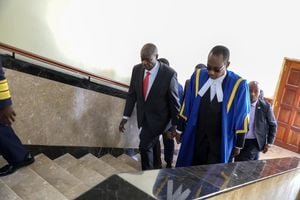How Kenya's debt crisis is undermining fight against HIV

A UN report shows that the debt crisis is jeopardising the progress made towards ending AIDs in Eastern and Southern Africa.
What you need to know:
- According to the report, several countries are not prioritising HIV funding.
- Foreign donors currently finance at least 66 per cent of HIV budget in Kenya.
In New York, UN Headquarters
Growing public debt is suffocating Kenya and other sub-Saharan African countries, leaving them with little fiscal space to fund health and essential HIV services, as per a new report.
The report, released on Saturday at a side event during the 79th United Nations General Assembly in New York by the Joint United Nations Programme on HIV/AIDS (UNAIDS), shows that the debt crisis is jeopardising the progress made towards ending AIDS in Eastern and Southern Africa.
The report titled “Domestic Revenues, Debt Relief, and Development Aid: Transformative pathways for ending AIDS by 2030” shows that financing has become much more challenging for countries to provide care for HIV patients.
“High public debt, elevated borrowing costs, high inflation, weak public finances and a decline in foreign investment are putting pressure on funding for the HIV response at a time when resources are most needed.”
It adds: “Other competing priorities have the potential to redirect much-needed international funds away from health and the HIV response. Of all world regions, a renewed commitment to fully fund the HIV response could have the greatest impact in eastern and southern Africa, which remain at the epicentre of the HIV epidemic with 52 per cent of all people living with HIV in the world."
The report shows that the combination of growing public debt payments and spending cuts set out in International Monetary Fund agreements in the next three to five years will, if unaddressed, leave countries dangerously under-resourced to fund their HIV responses.
“When countries cannot effectively look after the health care needs of their people because of debt payments, global health security is put at risk,” said UNAIDS Executive Director Winnie Byanyima. “Public debt needs to be urgently reduced and domestic resource mobilization strengthened to enable the fiscal space to fully fund the global HIV response and end AIDS.”
According to the report, with the decline of international funding, several countries are not prioritising HIV funding hence not doing much.
It sets out to identify how to unlock resources at scale and speed from all domestic and external public sources to fulfil the commitments set out in the 2021 political declaration on HIV and Aids, ending inequalities and getting on track to end Aids by 2030.
In 2022, $9.8 billion in funding was available for the HIV response, of which $5.19 billion (61per cent) came from international donors and $3.9 billion from domestic sources (public and private).
In 2020, development aid to the region fell from $30.3 billion in 2020 to $26.3 billion in 2021, an almost 13 per cent decrease. This reflects a decline which was already underway before the Covid-19 pandemic.
Despite commitments to increase domestic spending on the HIV response, countries face continued challenges of low domestic tax revenues.
Two donors, the United States (US) President’s Emergency Plan for AIDS Relief (PEPFAR) programme and the Global Fund provided 53 per cent of all international development assistance resources to the region. This leaves the region vulnerable to shifts in aid priorities, particularly given that many countries within the region are dependent on donors for almost all of the funding needed for the HIV response.
Foreign donors currently finance at least 66 per cent of the HIV budget in Kenya, mostly buying antiretroviral drugs and related supplies. The country’s domestic contribution has been rising since 2018 and currently stands at about 34 per cent, according to the National Syndemic Diseases Control Council, which develops HIV policy in Kenya.
Kenya’s main donor is the US President’s Emergency Plan for Aids Relief (Pepfar), which is struggling to secure a five-year, $6·8 billion funding from the US Congress.
Sub-Saharan Africa accounts for the largest number of people living with HIV, with more than 25.9 million people of the 39.9 million living with HIV globally. The region’s success in reducing new HIV infections by 56 per cent since 2010 will not be sustained if fiscal space is constrained.
Kenya, Angola, Malawi, Rwanda, Uganda, and Zambia. Even after debt relief measures, Zambia will still be paying two-thirds of their budget on debt servicing between 2024 and 2026.
Many countries within the region still have not seen a return to pre-pandemic levels of revenues. Across the region, tax revenues fell by 0.9 per cent of GDP between 2017 and 2023 from 16.3 per cent in 2017 to 15.4 per cent of GDP.





